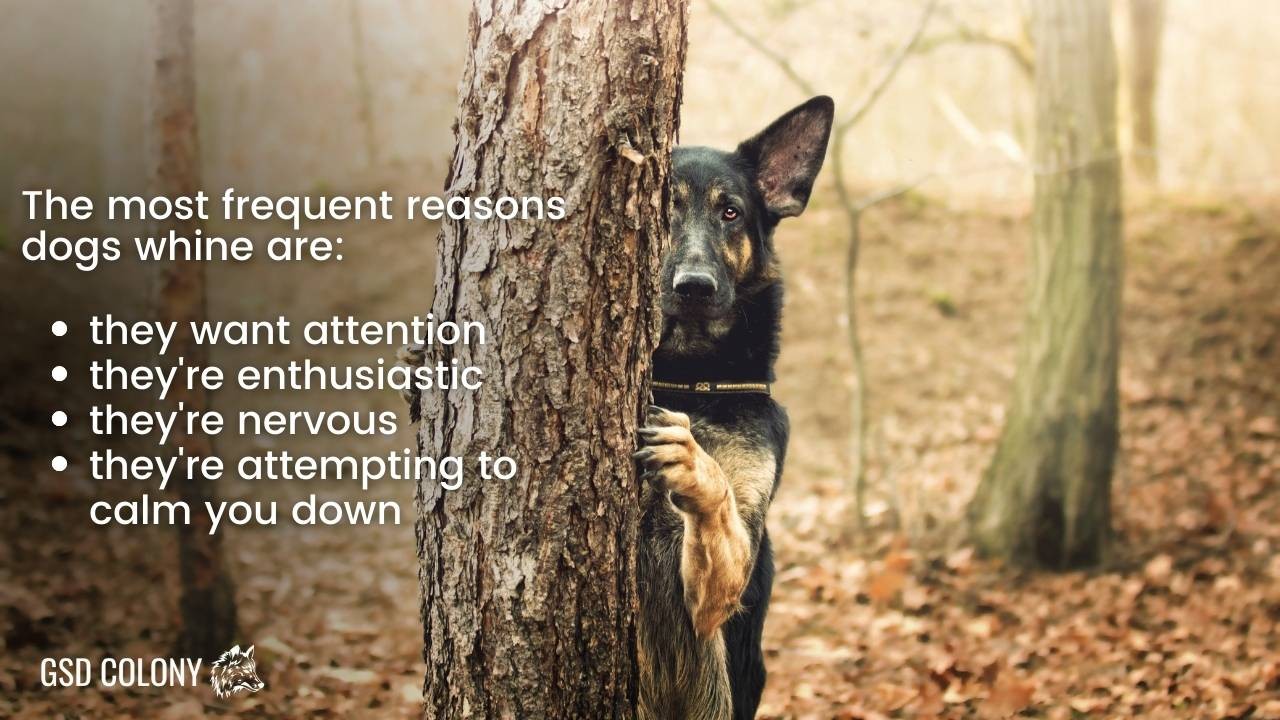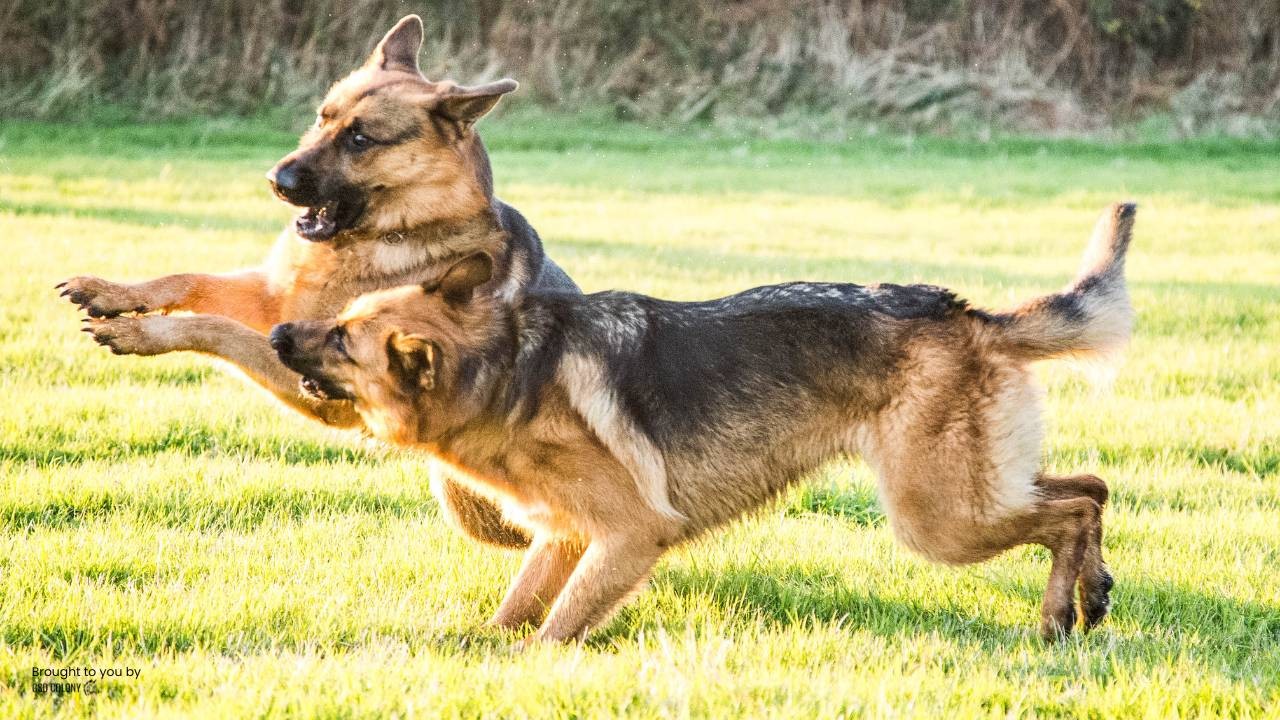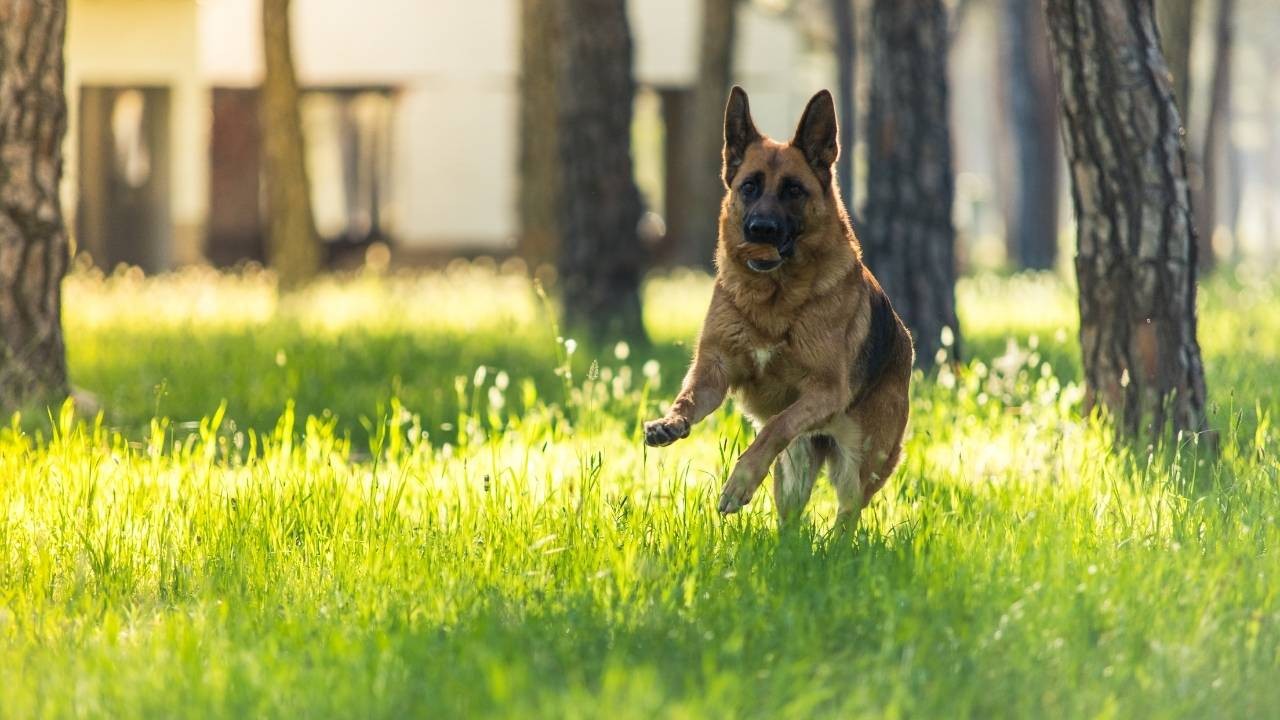Why Do German Shepherds Whine? This vocalization is a common behavior in German shepherds, and understanding the reasons behind the whining can help owners address their dog’s needs effectively. At WHY.EDU.VN, we provide in-depth explanations and solutions to help you build a stronger bond with your furry friend, offering valuable insights into canine communication and behavior. Learn about separation anxiety, attention-seeking, and underlying medical conditions, all while enhancing your dog ownership experience.
1. Understanding Why German Shepherds Are So Vocal
German shepherds are naturally vocal dogs, utilizing a range of sounds like barking, howling, and whining to communicate with humans and other animals. Their vocal nature stems from their strong social instincts and their desire to express emotions and needs. Understanding why your German shepherd is vocal is the first step in addressing excessive whining.
The primary reasons for their vocalizations include:
- Expressing Emotions: German shepherds use vocalizations to convey fear, excitement, anxiety, and happiness.
- Communicating Needs: They whine to signal hunger, thirst, the need for attention, or a desire to go outside.
- Responding to Environment: Changes in their surroundings or routines can trigger whining, especially if they feel insecure or anxious.
Understanding these underlying reasons helps you to respond appropriately to your dog’s needs and create a stronger, more understanding relationship.
2. Ten Common Reasons Why Your German Shepherd Is Whining
German shepherds whine for a variety of reasons, often related to their emotional state or physical needs. Here are ten of the most common reasons why your German shepherd might be whining:
- Expressing Fear or Anxiety: Whining can be a sign that your dog is feeling scared, anxious, or stressed.
- Alerting to Danger: They may whine to warn you of potential threats or dangers in their environment.
- Seeking Attention: Whining is often used to get your attention, especially if they want food, a toy, or playtime.
- Showing Excitement: Excitement can also lead to whining, particularly when anticipating a walk, treat, or enjoyable activity.
- Seeking Comfort: Dogs may whine when they need reassurance or comfort, especially if they are feeling unwell or insecure.
- Communicating with Other Dogs: Whining can be a way for German shepherds to communicate with other dogs, indicating their intentions or emotions.
- Experiencing Separation Anxiety: Being left alone can trigger whining in dogs with separation anxiety.
- Due to Boredom or Loneliness: Lack of mental or physical stimulation can lead to whining as a sign of boredom or loneliness.
- Because of Pain, Discomfort, or Illness: Physical discomfort or illness can cause whining as a way to signal distress.
- Lack of Expressive Skills: Puppies often whine more because they haven’t yet learned how to express themselves through body language alone.
3. Whining as an Expression of Fear or Anxiety
German shepherds often whine when they feel scared or anxious. This behavior is a way for them to communicate their distress and seek reassurance from their owners. Changes in their environment, loud noises, or unfamiliar people can trigger anxiety, leading to whining.
Recognizing Signs of Fear and Anxiety:
- Excessive barking or whining
- Panting
- Pacing
- Trembling
- Hiding or avoidance
- Tail tucked between legs
- Increased aggression
Addressing Fear and Anxiety:
- Identify Triggers: Determine what is causing your dog’s fear or anxiety.
- Create a Safe Space: Provide a quiet, comfortable area where your dog can retreat when feeling anxious.
- Desensitization and Counterconditioning: Gradually expose your dog to the source of their fear while pairing it with positive reinforcement, such as treats or praise.
- Professional Help: Consult a veterinarian or certified dog behaviorist for further assistance.
4. Whining to Alert You to Potential Danger
German shepherds have a strong protective instinct, and they may whine to alert you to potential dangers. This behavior stems from their history as herding dogs, where they were responsible for guarding livestock. When a German shepherd perceives a threat, they may whine to warn you and others nearby.
Recognizing Warning Signs:
- Whining accompanied by alert posture
- Barking or growling
- Pacing back and forth
- Staring intently at the perceived threat
- Ears perked up and pointing forward
Responding to Alert Whining:
- Assess the Situation: Determine if there is a genuine threat.
- Acknowledge Your Dog: Let your dog know you appreciate their warning.
- Take Appropriate Action: If there is a threat, take steps to protect yourself and your dog.
- Remain Calm: Your dog will mirror your emotions, so staying calm can help reassure them.
5. The Quest for Attention: Why German Shepherds Whine
German shepherds are highly social animals that thrive on human interaction. They often whine to get attention from their owners, whether it’s for food, playtime, or simply affection. This behavior is a way for them to strengthen their bond with you and ensure their needs are met.
Common Signs of Attention-Seeking:
- Whining
- Barking
- Pawing or pushing against you
- Following you around the house
- Staring intently at you
- Bringing toys to you
Addressing Attention-Seeking Whining:
- Provide Regular Attention: Set aside time each day to give your dog focused attention, such as playtime, walks, or cuddling.
- Ignore Whining: If your dog is whining for attention, ignore the behavior until they stop. Then, reward them with attention when they are quiet.
- Teach Alternative Behaviors: Train your dog to perform a specific behavior, such as sitting or staying, to earn your attention.
- Mental Stimulation: Provide puzzle toys and training sessions to keep your dog mentally engaged.
6. Expressing Excitement Through Whining
Excitement is another common reason why German shepherds whine. Whether they’re anticipating a walk, a treat, or a visit from a favorite person, their excitement can manifest as whining. This behavior is a way for them to express their joy and anticipation.
Recognizing Signs of Excitement:
- Whining
- Tail wagging
- Bouncing or jumping
- Running in circles
- Barking
Managing Excitement Whining:
- Stay Calm: Avoid getting overly excited yourself, as this can amplify your dog’s excitement.
- Teach a “Quiet” Command: Train your dog to respond to a “quiet” command to help them control their vocalizations.
- Provide Exercise: Ensure your dog gets plenty of physical activity to burn off excess energy.
- Reward Calm Behavior: Reward your dog when they remain calm and quiet in exciting situations.
7. Seeking Comfort: The Soothing Whine of a German Shepherd
German shepherds often whine when they are seeking comfort. This behavior can occur when they are feeling scared, anxious, or physically uncomfortable. By whining, they are communicating their need for reassurance and care.
Recognizing Signs of Discomfort:
- Whining
- Panting
- Hiding or seeking secluded areas
- Trembling
- Excessive yawning
- Licking lips or nose
- Avoidance of eye contact
- Aggressive behavior
Providing Comfort:
- Offer Reassurance: Speak to your dog in a calm, soothing voice and offer gentle petting.
- Create a Safe Space: Ensure your dog has a comfortable, secure area where they can retreat when feeling overwhelmed.
- Address Physical Discomfort: If you suspect your dog is in pain, consult a veterinarian.
- Provide a Comfort Item: Offer a favorite toy or blanket to help your dog feel more secure.
8. Canine Communication: How German Shepherds Use Whining with Other Dogs
German shepherds use whining as a form of communication with other dogs. This behavior can convey a variety of messages, including greetings, invitations to play, or expressions of submission or fear.
Interpreting Whining in Dog-to-Dog Interactions:
- Greetings: Whining can be a friendly greeting, often accompanied by tail wagging and sniffing.
- Play Invitations: Dogs may whine to initiate play, along with play bows and excited body language.
- Submission: Whining can indicate submission, especially when interacting with a more dominant dog.
- Fear: If a dog is feeling scared or threatened, they may whine as a sign of distress.
Managing Dog-to-Dog Interactions:
- Supervise Interactions: Always supervise interactions between dogs to ensure they are safe and positive.
- Intervene if Necessary: If you notice signs of aggression or distress, separate the dogs immediately.
- Socialization: Expose your dog to a variety of dogs in controlled environments to help them develop good social skills.
- Positive Reinforcement: Reward positive interactions with treats and praise.
9. Separation Anxiety: The Lonely Whine of a German Shepherd
Separation anxiety is a common issue in German shepherds, and whining is one of the primary symptoms. Dogs with separation anxiety become distressed when left alone, leading to a range of behaviors, including excessive whining, barking, and destructive behavior.
Recognizing Signs of Separation Anxiety:
- Excessive whining or barking
- Pacing or restlessness
- Destructive behavior (e.g., chewing furniture)
- Urination or defecation indoors
- Attempting to escape
Managing Separation Anxiety:
- Gradual Desensitization: Slowly increase the amount of time your dog is left alone, starting with just a few minutes and gradually working up to longer periods.
- Create a Safe Space: Provide a comfortable, secure area where your dog can retreat when you leave.
- Provide Mental Stimulation: Offer puzzle toys or a stuffed Kong to keep your dog occupied while you’re away.
- Medication: In severe cases, a veterinarian may prescribe medication to help manage anxiety.
- Professional Help: Consult a veterinarian or certified dog trainer for personalized guidance.
10. Alleviating Boredom and Loneliness to Reduce Whining
Boredom and loneliness are significant contributors to whining in German shepherds. These intelligent and active dogs require plenty of mental and physical stimulation to stay happy and well-behaved. When they are left alone for extended periods with nothing to do, they may resort to whining as a way to express their frustration.
Addressing Boredom and Loneliness:
- Provide Daily Exercise: Ensure your dog gets at least 30-60 minutes of exercise each day, such as walks, runs, or playtime.
- Offer Mental Stimulation: Provide puzzle toys, training sessions, and interactive games to keep your dog mentally engaged.
- Social Interaction: Arrange playdates with other dogs or enroll your dog in doggy daycare to provide social interaction.
- Rotate Toys: Keep your dog interested by rotating their toys regularly.
- Consider a Companion: If possible, consider getting another dog to provide companionship.
11. Medical Issues: When Whining Signals Pain or Discomfort
Whining can be a sign that your German shepherd is experiencing pain or discomfort due to an underlying medical condition. It’s essential to pay attention to your dog’s behavior and seek veterinary care if you suspect they are in pain.
Common Medical Conditions That Cause Whining:
- Arthritis
- Hip dysplasia
- Dental problems
- Ear infections
- Urinary tract infections
- Gastrointestinal issues
- Injuries
Recognizing Signs of Pain or Discomfort:
- Whining
- Limping
- Changes in appetite
- Lethargy
- Excessive licking
- Panting
- Aggression
What to Do:
- Consult a Veterinarian: If you suspect your dog is in pain, schedule an appointment with your veterinarian for a thorough examination.
- Follow Treatment Plan: Follow your veterinarian’s recommendations for pain management, which may include medication, physical therapy, or surgery.
- Provide a Comfortable Environment: Ensure your dog has a comfortable, quiet place to rest and recover.
12. Puppy Vocalizations: Understanding Why Young German Shepherds Whine
German shepherd puppies often whine more than adult dogs because they are still learning how to communicate their needs and emotions. Whining is a common way for puppies to signal hunger, discomfort, or the need for attention.
Understanding Puppy Whining:
- Hunger: Puppies need frequent meals, and they may whine when they are hungry.
- Discomfort: Puppies may whine if they are too hot, too cold, or need to eliminate.
- Attention: Puppies crave attention and may whine to get your affection.
- Anxiety: New environments or being left alone can cause anxiety, leading to whining.
Managing Puppy Whining:
- Meet Basic Needs: Ensure your puppy has access to food, water, and a comfortable place to rest.
- Potty Breaks: Take your puppy out for frequent potty breaks to prevent accidents.
- Provide Attention: Spend time playing and cuddling with your puppy to meet their social needs.
- Training: Start training early to teach your puppy appropriate behaviors and communication skills.
- Socialization: Expose your puppy to a variety of people, places, and sounds to help them become well-adjusted adults.
13. Proven Methods to Stop Your German Shepherd from Whining
Addressing excessive whining in German Shepherds requires understanding the root cause and applying appropriate strategies. Here are effective methods to help stop your German Shepherd from whining.
| Method | Description | How to Implement |
|---|---|---|
| 1. Monitor and Limit Stimulation | Reduce exposure to excessive noise, people, and animals to prevent over-stimulation. | Identify triggers and gradually desensitize your dog to them. Create a calm environment by limiting exposure to stressors. |
| 2. Regular Exercise | Ensure adequate daily physical activity to burn off excess energy and reduce anxiety. | Provide at least 30-90 minutes of daily exercise, including walks, runs, and playtime. Adjust the intensity based on your dog’s age, size, and health. |
| 3. Mental and Physical Stimulation | Engage your dog with activities that stimulate their mind, reducing boredom and anxiety. | Use puzzle toys, brain teasers, and agility training. Teach new tricks and commands to keep them mentally stimulated. |
| 4. Ignore the Whining | Avoid reinforcing whining by giving attention or comfort. | Ensure your dog’s needs are met (e.g., not in pain, has water). Then, ignore the whining until it stops. Reward them with praise or treats when they are quiet for a few minutes. |
| 5. Identify Root Cause | Determine the underlying reason for the whining (e.g., fear, anxiety, boredom). | Observe your dog’s behavior and context to identify triggers. Consult with a veterinarian or dog behaviorist for professional assessment. |
| 6. Positive Reinforcement | Use rewards like food, toys, or praise to reinforce desired behaviors. | Reward your dog when they are quiet and calm. Use treats, praise, or favorite toys to positively reinforce good behavior. |
| 7. Veterinary Consultation | Seek professional veterinary advice if the whining persists or you suspect a medical issue. | Schedule a vet appointment for a check-up and diagnosis to rule out any underlying medical conditions. Follow the veterinarian’s recommendations for treatment. |



14. Interpreting the High-Pitched Whine: Anxiety or Excitement?
A high-pitched whine in German Shepherds can indicate either anxiety or excitement, making it essential to observe accompanying body language to understand the dog’s emotional state accurately.
| Feature | Anxiety | Excitement |
|---|---|---|
| Body Language | Tucked tail, lowered head, trembling, pacing, hiding | Wagging tail, bouncy movements, alert posture, playful behavior |
| Facial Expression | Tense, wide eyes, lip licking, yawning | Relaxed, bright eyes, open mouth, panting |
| Vocalization | High-pitched, continuous whining with possible whimpering | High-pitched, intermittent whining with barking or yipping |
| Context | New environments, loud noises, separation from owner, unfamiliar people or animals | Anticipation of a walk, treat, playtime, arrival of a favorite person |
Example Scenarios:
- Anxiety: A German Shepherd whines in a high-pitched tone while hiding under the bed during a thunderstorm.
- Excitement: A German Shepherd whines excitedly, wagging its tail, when its owner picks up the leash for a walk.
Understanding these distinctions can help you respond appropriately to your dog’s needs, providing comfort or channeling their energy effectively.
15. Health-Related Issues Triggering Whining in German Shepherds
Whining in German Shepherds can sometimes indicate underlying health issues. Recognizing these potential health-related causes is crucial for timely intervention and care.
| Health Issue | Symptoms | Potential Causes | Diagnostic Steps |
|---|---|---|---|
| 1. Pain or Discomfort | Whining, limping, changes in appetite, lethargy | Hip dysplasia, arthritis, injuries, dental problems, internal discomfort | Physical exam, X-rays, blood tests |
| 2. Anxiety or Stress | Whining, pacing, excessive licking, hiding | Separation anxiety, fear, environmental stressors | Behavioral assessment, rule out medical causes |
| 3. Neurological Disorders | Whining, disorientation, seizures, tremors | Epilepsy, tumors, infections | Neurological exam, MRI, cerebrospinal fluid analysis |
| 4. Gastrointestinal Issues | Whining, vomiting, diarrhea, loss of appetite | Bloating, constipation, dietary intolerances, infections | Physical exam, blood tests, fecal analysis, abdominal X-rays |
| 5. Ear or Eye Problems | Whining, head shaking, pawing at ears or eyes, discharge | Infections, inflammation, foreign objects | Physical exam, otoscopic exam, ophthalmic exam |
Statistics and Facts:
- Hip Dysplasia Prevalence: Studies suggest that up to 20% of German Shepherds are affected by hip dysplasia.
- Anxiety-Related Issues: German Shepherds rank high among breeds prone to separation anxiety, with behavioral studies indicating that around 14% may suffer from this condition.
- Sensitivity to Pain: Research shows that certain breeds, including German Shepherds, may have a higher sensitivity to pain, making them more likely to vocalize when in discomfort.
By understanding the potential health-related causes of whining, owners can be more proactive in caring for their pet’s physical and emotional well-being. If your German Shepherd is whining more than usual and you suspect it might be health-related, it’s essential to consult a veterinarian.
16. Addressing Nighttime Whining in German Shepherds
Nighttime whining in German Shepherds can be disruptive and indicates underlying issues that need attention. Common causes include anxiety, loneliness, discomfort, or unmet needs.
Strategies to Address Nighttime Whining:
- Ensure Comfort:
- Provide a comfortable bed in a safe, quiet location.
- Maintain a consistent room temperature.
- Meet Needs Before Bedtime:
- Ensure your dog has ample opportunity to relieve themselves before bed.
- Provide a late-night snack if hunger is a concern.
- Provide Mental Stimulation:
- Engage in a calming activity before bedtime, such as gentle grooming or a quiet walk.
- Offer a puzzle toy to keep them occupied.
- Address Anxiety:
- Use calming aids like a Thundershirt or pheromone diffuser.
- Create a consistent bedtime routine to reduce anxiety.
- Ignore Attention-Seeking:
- If you suspect the whining is for attention, ignore it to avoid reinforcing the behavior.
- Ensure all needs are met before bedtime, so you can confidently ignore the whining.
If the nighttime whining persists, consult a veterinarian or certified dog behaviorist to rule out medical issues or develop a tailored behavior modification plan.
17. Deciphering the Whine During Petting: Comfort or Discomfort?
When a German Shepherd whines while being petted, it can indicate either enjoyment or discomfort. The key is to interpret the dog’s body language and the context of the situation.
Signs of Comfort:
- Relaxed posture
- Soft facial expression
- Leaning into the touch
- Tail wagging gently
- Closed or partially closed eyes
Signs of Discomfort:
- Tense posture
- Ears pinned back
- Turning away from the touch
- Lip licking
- Yawning
- Whale eye (whites of the eyes showing)
- Stiff body
Actionable Steps:
- Observe Body Language: Pay close attention to your dog’s overall body language to determine whether they are enjoying the petting.
- Adjust Technique: If you notice signs of discomfort, adjust your petting technique or stop altogether.
- Respect Boundaries: Allow your dog to initiate and control the interaction.
- Check for Sensitivity: Rule out any potential medical issues by consulting a veterinarian.
18. The Greeting Whine: Why German Shepherds Vocalize Upon Seeing You
When a German Shepherd whines upon seeing their owner, it is typically a sign of excitement and affection. This behavior reflects their strong bond and happiness at the reunion.
Underlying Reasons:
- Excitement: Dogs vocalize when they are happy to see their favorite person.
- Affection: Whining is a way to express their love and attachment.
- Anticipation: They anticipate positive interactions like petting, playtime, or walks.
- Submissive Greeting: Some dogs whine as a submissive greeting to show respect.
How to Respond:
- Acknowledge the Greeting: Greet your dog calmly to avoid escalating their excitement.
- Provide Affection: Offer gentle petting or verbal praise.
- Maintain Calm Demeanor: Avoid overly enthusiastic responses to prevent reinforcing excessive whining.
- Establish Routine: Consistent greetings can help manage their excitement over time.
19. Are German Shepherds More Vocal Than Other Dog Breeds?
German Shepherds are indeed known to be more vocal than many other dog breeds. Their tendency to bark, growl, and whine is often attributed to their intelligence, protective nature, and strong communication needs.
| Feature | German Shepherds | Other Dog Breeds |
|---|---|---|
| Vocalization Frequency | High | Moderate to Low |
| Purpose of Vocalization | Communication, guarding, expressing emotions, seeking attention | Primarily communication and guarding |
| Training Impact | Requires consistent training to manage barking and whining | May require less intensive vocalization management |
| Common Vocalizations | Barking, whining, growling, howling | Barking, occasional whining |
| Social Needs | High social needs, vocalization often related to interaction | Varying social needs, less vocalization related to interaction |
While vocalization is a breed trait, individual dogs can vary. Proper training and understanding of their communication needs can help manage excessive vocalization.
20. Leveraging WHY.EDU.VN for Your German Shepherd’s Well-Being
At WHY.EDU.VN, we understand the unique challenges and joys of owning a German Shepherd. Our platform offers a wealth of information and expert advice to help you provide the best possible care for your furry friend. Whether you’re dealing with excessive whining, separation anxiety, or other behavioral issues, our resources can guide you every step of the way.
How WHY.EDU.VN Can Help:
- Expert Articles: Access in-depth articles on German Shepherd behavior, training, and health.
- Community Forum: Connect with other German Shepherd owners to share experiences and advice.
- Ask a Vet: Get answers to your questions from qualified veterinarians.
- Training Guides: Learn effective training techniques to manage unwanted behaviors.
By leveraging the resources available at WHY.EDU.VN, you can build a stronger, more fulfilling relationship with your German Shepherd and ensure their well-being.
Is your German Shepherd still whining and you’re unsure why? Visit WHY.EDU.VN today. Our experts are ready to help you uncover the reasons behind your dog’s behavior and provide tailored solutions. Connect with us at 101 Curiosity Lane, Answer Town, CA 90210, United States, or reach out via WhatsApp at +1 (213) 555-0101. Let WHY.EDU.VN be your trusted resource for all your pet care questions.
Frequently Asked Questions (FAQ)
1. What are German Shepherds afraid of?
German Shepherds can be afraid of loud noises, unfamiliar people or animals, and changes in routine. Introducing them to new environments gradually can help.
2. Do all German Shepherds whine?
No, not all German Shepherds whine. However, they tend to be more vocal than other breeds and may whine if uncomfortable or scared.
3. How do I calm my anxious German Shepherd?
Provide a sense of security, structure, and routine. A consistent feeding schedule and regular exercise can help reduce anxiety.
4. How can I tell if my German Shepherd is sad?
Signs include reduced activity, lack of interest in enjoyable activities, sleeping more than usual, and loss of appetite.
5. Are German Shepherds affectionate?
Yes, they are known to be particularly affectionate and loyal dogs. They bond strongly with their owners and love to cuddle.
6. Why do German Shepherds need so much attention?
They are highly social dogs that crave companionship and interaction. Without attention, they may suffer from boredom or loneliness.
7. Do German Shepherds get separation anxiety?
Yes, this is a common issue. Provide mental stimulation and gradually increase the time they are left alone.
8. What calms a whining dog?
Structure, routine, regular exercise, and a safe space can help calm a whining dog. Additionally, ensure all their needs are met and show them plenty of love and affection.
By addressing these common concerns and utilizing the resources at why.edu.vn, you can better understand and care for your German Shepherd, promoting a happy and healthy life together.
